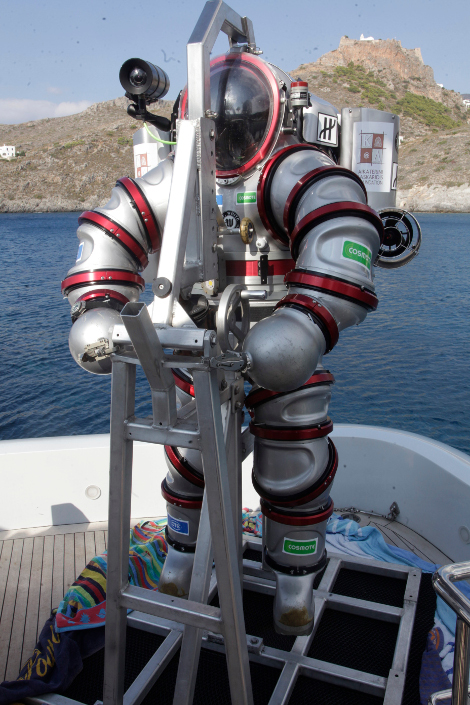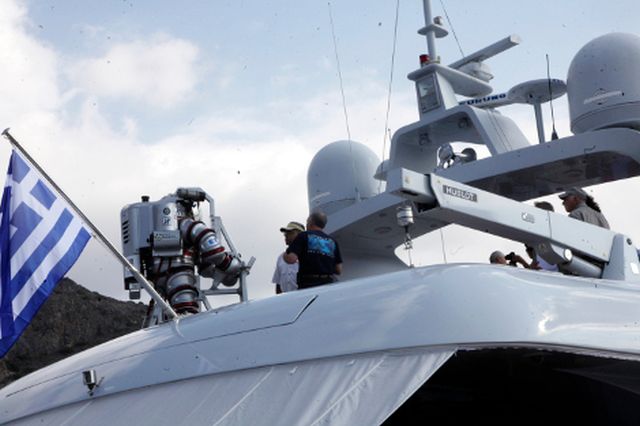The findings of the underwater excavation of the shipwreck near Antikythera are considered very important, and the results are expected to be announced in the coming days.
Angeliki Simosi, head of the Office for Underwater Archaeological Monuments mentions the possibility of building an underwater museum, as at the bottom near the island there are probably objects from different eras and, as the specialist said, it is possible that there are statues in it even more significant than the ones already discovered. According to Angeliki Simosi, it is possible that there is a whole complex of statues at the bottom.
The studies
Since September 15, members of the research team consisting of Greek, American and Swiss scientists have been looking at a depth of 300 metres for remains of the ancient shipwreck that had hidden the famous mechanism. Diving activities and geophysical surveys with metal detecting devices are already underway.

Equipment meeting space standards
The studies will be carried out using a new wetsuit of Canadian production worth € 1.5 million.
 The suit is called Εxosuit, and it provides greater flexibility to divers and the ability to remain a long time in the water, without it being necessary to go through the process of depressurization afterwards. The suit weighs 240 kg and is made of aluminium alloy.
The suit is called Εxosuit, and it provides greater flexibility to divers and the ability to remain a long time in the water, without it being necessary to go through the process of depressurization afterwards. The suit weighs 240 kg and is made of aluminium alloy.
Εxosuit looks like a spacesuit worn by astronauts. It has manoeuvring devices that support navigation by the operator, special pedals for the feet of the diver, with which they can control the direction of motion, robotic arms with a clip at the end, special lights, a camera and intercom.
The suit is connected to the surface by a cable, through which it is fed with electric power and optical communication. A chemical substance captures carbon dioxide in the cabin, and a special mechanism fills the space with the necessary quantity of oxygen.
On Monday, weather permitting, the new Exosuit diving suit is expected to be tested for the first time. On Friday, a special event was organized on the island during which the avant-garde costume was presented.

The shipwreck near Antikythera
The artefacts discovered so far indicate that the cargo ship that shipwrecked near the island, was carrying not only the Antikythera mechanism, but also many other items. As econews.gr says, it is believed that the ship was carrying even artwork, that had sunk to a greater depth. Around the coasts of Antikythera another shipwreck has been discovered, about 250 meters away from the first one, the experts not excluding the possibility that a second mechanism had existed, since it is assumed that both ships had been travelling together.
The shipwreck was discovered accidentally by sponge hunters in 1900 at a depth of 55 metres. With the help of the equipment of the time, the Antikythera mechanism and unique masterpieces were withdrawn to the coast, such as the statue of the youth and the statue of the philosopher of Antikythera.
The shipwreck near Antikythera was studied again in 1976 by the famous French explorer Jacques-Yves Cousteau.

The Antikythera mechanism
The Antikythera mechanism (also known as the astrolab or the Antikythera "computer") is an ancient device which is considered to be an instrument for astronomical observations, or a kind of mechanical computer. Based on the Greek inscriptions on it, it is dated between 150 BC and 100 BC, well before the year of the shipwreck, which supposedly happened between 87 BC and 63 BC. It might have been built also half a century before the shipwreck. The Antikythera mechanism is the oldest preserved machine containing cogwheels, and an extremely complex device. It was made of bronze and had a wooden frame.